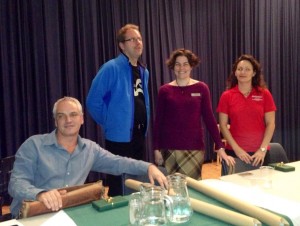Fleming College: On GIS Day It’s About Careers
GIS Day, having been a few days ago, is still hot on my mind. Here at Fleming, there was a half-day event with four guest speakers: Tammy Sikma (GIS Manager, Peterborough County), Paul Heersink (Community Mapping Project, ESRI Canada), Vanessa Michalsen (MNR, Provincial Geomatics Service Center), and Shawn Bulbrook (IT Architect, Scalar Decisions Inc.). This year, the emphasis was generally on cartography. All that said and done, there was one tidbit of information that seems to have resonated in my brain.

Strangely enough, it isn’t about cartography. Before I continue, just so you readers know, there was a lot of talk about what these folks have done to get where they are, and what they do now. For me, as a soon-to-be young professional, I benefited most from eachspeaker discussing what they thought to be the most important aspect to landing a job, keeping a job, and always being employable.
“Do you have any tips on getting a full time job in the field of GIS?” This question came up more than once, and it was interesting to hear what each speaker had to say about it. Resumes, interviews, attitude, and up-to-date training are all crucial, to put it briefly. Let me elaborate.
When applying to a job, the resume is the first thing your employer looks at. They say first impressions are crucial, so don’t fall short when it comes to your resume. Whether you like it or not, a resume is a first impression. I learned that in some places of employment, HR simply matches resumes to the job posting. If it’s a match, pull it, if not, leave it. Even if it is a match, if it is too lengthy, chances are it won’t get noticed. Advice? Keep it short and sweet and always adjust your resume to the job posting, however time consuming this may be.
My mother has always told me that nobody likes a cocky attitude. Well, in the world of interviews my friends, it’s called confidence. This is the one time to further that impression. In the wise words of Missy Elliot, when in an interview, you have no other option than to “work it”. What I mean by this is to sell yourself. We’ve all done GIS work before, whether that is in the field or in school. Students in the Fleming GIS program have been building a portfolio since September. I highly recommend this. Now, I can walk into an interview, present my work, and explain what and how I have done it. Further, know who you are applying to, and by golly research the company before you go into that interview! A common question I have faced in almost every interview is “What do you know about our company?” This is probably one question that shouldn’t go unanswered.
Moving forward, you have landed the job. What now? Stay keen! One of the speakers had mentioned that she was doing some “grunt work” when she started, if you will. Data entry is not ideal, but realistically, someone has to do it (and it’s likely going to be those new graduates!). Regardless, this person stayed eager. Not only did this keep them on the job, it allowed for internal training. Let me rephrase, paid internal training. If an employer can recognize your ability to stay enthusiastic about any job, it is going to pay off. Any form of training can only further your credentials, leaving you with more room to grow.
Lastly, and I would think most importantly, is training. Like I just mentioned, any type of relevant training will further anybody’s credentials in any field. As GIS is a rapidly changing field, this piece of advice could not hit home any harder. Take a look at the field of GIS over the last 20 years. What used to be rolls of paper maps are now digitized, interactive map layers. What used to be hard copy records are now relational databases. What used to be rulers, compasses, and markers, are now digital measurements. Need I say more? I can’t even begin to imagine what the next 10, even five years, in the field of GIS will bring. I think it would be an accurate assumption to say that GIS has the capability of expanding into every market.
This being said, it is absolutely crucial to maintain employability. The only way to stay current is to constantly learn. Put yourself in unfamiliar situations, with unfamiliar software, or unfamiliar people at a conference on project management, perhaps. Stay on top of industry trends, and know where the GIS industry is headed. One speaker, in particular, seeks technical training in something that is unfamiliar to him every three months. That deserves a round of applause.
I have heard that finding a full time job is a full time job. This is true. I now also believe that remaining employable is a whole other job in itself. On that note, I would like to thank each speaker for sharing with the students of Fleming College their experiences in the field of GIS, their advice, and expertise. Until next #GISDay, everybody!








